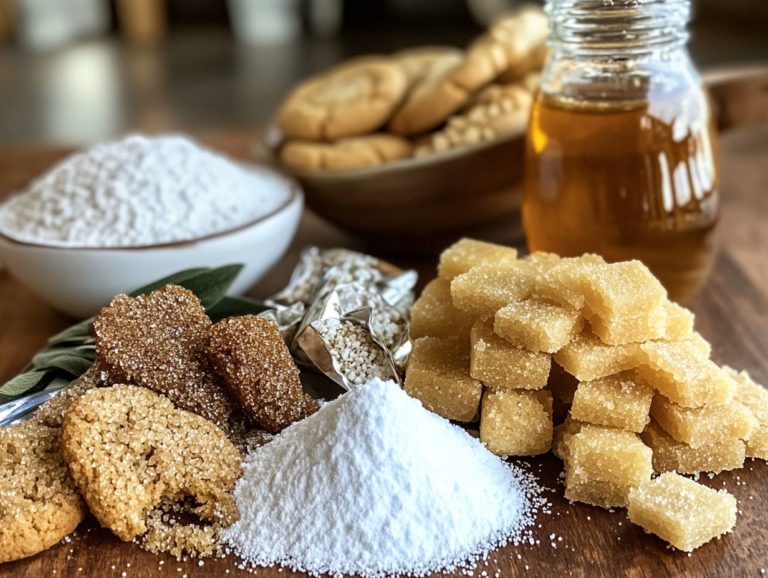How to Customize Desserts for Dietary Needs?
Contents
- Customizing Desserts for Dietary Needs
Customizing Desserts for Dietary Needs
Navigating the realm of dietary preferences can be quite the challenge, particularly when it comes to creating desserts that fit a healthy diet.
No matter if you re gluten-free, dairy-free, vegan, or adhering to specific diets like Paleo or Keto, your craving for a sweet indulgence shouldn t be sidelined. Even when following dietary restrictions, you can enjoy a variety of fruit-based desserts and vegetable desserts.
This article delves into various dietary needs and presents practical solutions, including ingredient substitutions, recipe conversions, and cooking tips. Let s dive into how you can create delicious desserts that everyone can enjoy!
Discover tips for customizing desserts that align with your unique requirements, ensuring that everyone can savor delightful, tailored treats that incorporate nutritious ingredients.
Key Takeaways:

- Understand the different dietary needs such as gluten-free, dairy-free, vegan, paleo, and keto to determine which substitutions and adjustments are needed for your dessert.
- Substitute ingredients such as flour, milk, eggs, and sugar with gluten-free, dairy-free, or plant-based alternatives to accommodate different dietary needs. Consider using whole wheat flour, almond flour, oat flour, and Greek yogurt in your recipes.
- Converting recipes for dietary needs may require adjusting measurements and cooking times and temperatures, so keep this in mind when customizing your desserts. You might also need to reduce sugar or use unsweetened cocoa to meet specific health goals.
Understanding Different Dietary Needs
Understanding diverse dietary needs is essential for crafting desserts that resonate with a variety of health trends and individual preferences. As more people embrace specific diets be it gluten-free, dairy-free, vegan, paleo, or keto the demand for desserts that accommodate these dietary restrictions has surged significantly.
This shift invites the use of wholesome ingredients that not only promote a healthy lifestyle but also deliver on taste and satisfaction. In this guide, you will delve into these dietary needs and their impact on dessert selections, highlighting the critical role of ingredient substitutions in enhancing flavor while maintaining healthful integrity.
1. Gluten-Free (Sydney Coons, Dashing Dish, October 2022)
Gluten-free diets are essential for you if you have celiac disease or gluten sensitivity, which means you need tasty alternatives that don t compromise on flavor or texture.
To elevate your cooking experience, consider the benefits of using flour substitutes like almond flour and oat flour.
Almond flour, with its subtly nutty flavor and moist texture, is ideal for crafting rich, chewy cookies or fluffy pancakes. On the other hand, oat flour adds a delightful heartiness to baked goods such as muffins and brownies. Whole wheat flour can also be a nutritious alternative to regular flour, if dietary restrictions allow.
When you opt for these gluten-free flours, it s vital to adjust your recipes by incorporating binding agents like eggs or flaxseed to ensure the structures hold up beautifully.
For instance, a delicious almond flour chocolate chip cookie can serve as a satisfying treat, or you might enjoy whipping up some oat flour banana bread for a wholesome breakfast option. You can also try making black bean brownies for an extra boost of protein.
Embracing these substitutes not only opens the door to healthy desserts but also caters to diverse dietary needs all without sacrificing taste or texture. Experimenting with different substitutes can help you find the best flavor combinations.
2. Dairy-Free (Nutrition Management, College of Health and Human Sciences)
Dairy-free diets are gaining traction, not just among those with lactose intolerance, but also for those like you who want to cut back on dairy for health reasons.
This trend towards dairy alternatives presents a wealth of options that suit various tastes and dietary preferences.
For instance, almond or coconut yogurt can replace Greek yogurt while providing a creamy texture. These options can elevate your healing smoothies or serve as a delightful base for savory sauces.
If you’re considering butter replacements, think about using avocado or nut butters. They not only provide healthy fats but also infuse your baked goods with a unique depth of flavor.
Try whipping up recipes like vegan mac and cheese with cashew cheese or a luscious coconut curry. These dishes can satisfy your cravings without compromising on taste, proving that a dairy-free lifestyle can indeed be both enjoyable and nourishing.
3. Vegan (Food Science, October 2022)
A vegan diet doesn’t include any animal products. This has sparked a rising interest in plant-based desserts that are not only delectable but also packed with nutrients.
Consider using applesauce or pumpkin puree as egg substitutes in your vegan baking. One particularly thrilling trend is the incorporation of unexpected yet wholesome ingredients, like black beans, into desserts such as fudgy brownies.
These brownies not only enhance the protein content but also introduce a delightful texture that surprises the palate. Another idea is to use avocados in chocolate mousse recipes for a creamy, nutritious dessert.
Using chocolate in different forms, from dark chocolate chips to raw cacao powder, elevates the flavor profiles while ensuring a health-conscious approach.
If you re looking to indulge without the guilt, explore healthy recipes online to unveil a treasure trove of possibilities for crafting perfect vegan treats.
Embrace cooking tips like using ripe bananas for natural sweetness or incorporating nut butters to enhance flavor while nourishing your body. This approach transforms creating delightful vegan desserts into a simple yet rewarding experience.
4. Paleo (Dashing Dish, October 2022)
The paleo diet, inspired by the dietary habits of our ancestors, places a strong emphasis on whole foods while shunning processed ingredients. This approach opens the door to innovative and creative dessert-making.
By looking into nutrient-dense flours like almond or coconut flour, you can elegantly reinvent classic desserts while staying true to this healthy lifestyle.
Embracing natural sweeteners such as honey, maple syrup, or even mashed bananas allows you to craft indulgent treats that satisfy your sweet tooth without jeopardizing your health goals.
For instance, try a sweet potato pie with a crust made of almond flour and sweetened with pure maple syrup an utterly delightful, guilt-free indulgence.
Other enticing recipes to consider include:
- coconut macaroons
- dark chocolate avocado mousse
Both beautifully highlight the versatility of paleo-friendly ingredients while adhering to the essential principles of nourishment.
5. Keto (Sydney Coons, October 2022)

The ketogenic diet emphasizes a low carbohydrate intake, inviting you to embrace healthy fats and proteins while significantly curbing sugar consumption even in your beloved desserts. You might try incorporating high-fiber vegetables like zucchini in your desserts to add nutrition without compromising keto principles.
This approach might pose a challenge, especially if you have a penchant for sweets. However, adapting traditional recipes can yield satisfying options that align beautifully with keto principles. By experimenting with low-carb sweeteners and healthy fats, you can create delightful treats.
For instance, by incorporating ingredients like unsweetened cocoa powder and high-percentage dark chocolate, you can indulge your dessert cravings while maintaining your dietary goals. Additionally, using butter alternatives can help preserve the creamy texture of your keto desserts.
Take, for example, a rich keto chocolate mousse crafted with unsweetened cocoa, heavy cream, and a low-carb sweetener. It s a creamy, decadent treat that won t derail your goals. Similarly, you can whip up keto-friendly brownies using almond flour, dark chocolate, and a sugar substitute creating a delightful option that supports a healthy lifestyle while satisfying your sweet tooth.
Substituting Ingredients for Dietary Needs (Food Science, October 2022)
Mastering the art of ingredient substitution is a vital cooking skill. It allows you to craft delectable desserts that cater to diverse dietary needs while aligning with a healthier diet and lifestyle. Incorporating nutritious ingredients like meringue or pavlova can add a unique twist to your desserts.
1. Flour Substitutes
When considering flour substitutes, options like almond flour and oat flour have surged in popularity due to their nutritional advantages and versatility. Whole wheat flour is another option for those not avoiding gluten.
Almond flour, made from finely ground almonds, brings a rich flavor to your creations while being packed with protein, healthy fats, and vitamin E. This makes it an outstanding choice for gluten-free baking or low-carb diets.
On the other hand, oat flour, made from ground whole oats, is rich in fiber and enhances the texture of baked goods, contributing a subtly sweet flavor.
These alternatives meet specific dietary needs and integrate seamlessly into various recipes. For example, you can use almond flour to whip up indulgent chocolate chip cookies, while oat flour is perfect for creating fluffy pancakes or muffins.
By incorporating these substitutes, you can embark on a delightful journey of new flavors while maintaining health-conscious choices in your kitchen.
2. Milk Substitutes
Milk substitutes are essential for anyone avoiding dairy and offer delightful options like coconut milk and Greek yogurt that deliver creamy textures and rich flavors to your desserts. Using nonfat dry milk powder can also provide similar benefits with a longer shelf life.
These alternatives cater to those who are lactose intolerant and attract those embracing plant-based diets. For example, almond milk adds a subtle nuttiness that enhances baked goods, while oat milk s creamy consistency elevates puddings and custards.
From a nutritional standpoint, these substitutes often boast fewer calories and added vitamins, making them a healthier choice for many recipes. Imagine using cashew milk in a decadent chocolate mousse or coconut cream in a light panna cotta both dishes highlight the impressive versatility of these nutritious ingredients and significantly enhance your overall taste experience.
Get ready to enjoy delicious keto desserts that won t derail your goals! Try experimenting with these suggestions and discover new favorites.
3. Egg Substitutes
Discovering effective egg substitutes can truly transform your baking experience, especially if you’re navigating dietary restrictions or allergies. These substitutes play a crucial role in binding and leavening your baked goods, which helps them rise and achieve the right texture.
By looking into various options like flaxseed meal, applesauce, and pumpkin puree, you can achieve delightful flavors and the perfect texture without sacrificing your health. For example, when you mix flaxseed meal with water, it forms a gel-like consistency that mimics the properties of eggs, making it an excellent addition to muffins and pancakes.
Unsweetened applesauce not only adds moisture but also infuses a natural sweetness into recipes like waffles and cakes. By utilizing these clever substitutes, you can indulge in your favorite treats while staying true to your dietary choices, making it easier than ever to create wholesome, egg-free delights.
4. Sugar Substitutes
Sugar substitutes are essential for crafting desserts that satisfy your cravings without sacrificing your health. They allow you to relish sweetness while reducing your sugar intake. These alternatives come in many forms, ranging from natural options like stevia and monk fruit to artificial sweeteners such as aspartame and sucralose. Each type offers its own unique flavor profile and texture, which can dramatically transform the final product.
When you aim to indulge without guilt, choosing the right sugar substitute becomes paramount. By incorporating these sweeteners, you maintain a lower caloric count while enhancing the taste experience in innovative ways, paving the way for exciting new dessert creations. For instance, when making chocolate chip cookies, you could swap traditional sugar for a blend of coconut sugar and erythritol, preserving the cookies’ rich caramel flavor and chewy texture. Similarly, using agave nectar in a fruit tart delivers a natural sweetness that beautifully complements the fruit without overwhelming it.
Get creative with these substitutes to whip up incredible desserts like sweet potato pie and black bean brownies, ensuring that your indulgence doesn t come at the expense of your health. With a dash of creativity, even your classic favorites can be reimagined to meet your dietary needs.
Converting Recipes for Dietary Needs

To convert recipes for specific dietary needs, you must grasp the nuances of ingredient substitutions while making precise adjustments to cooking times and measurements. This careful attention will ensure that your culinary creations yield optimal results tailored to your requirements.
1. Converting Measurements
Accurate measurement conversions are essential when adapting recipes to suit your dietary needs, as they ensure that the final product retains its taste and texture.
For instance, if a recipe calls for one cup of all-purpose flour and you decide to substitute it with almond flour, knowing the correct conversion is crucial to prevent any mishaps in texture. Using nutrient-dense flours like whole wheat flour or oat flour can add more fiber and nutrients to your baked goods. Using too much or too little can result in dry or overly dense baked goods. Precision is especially vital in recipes like souffl s or macarons, where even the slightest deviation can impact how they rise and their final structure.
It s not merely about swapping ingredients; it s about understanding how each component interacts and contributes to the overall balance of flavors and textures. For example, nonfat dry milk powder can be a useful addition to add protein without adding extra fat. Recognizing that one tablespoon of cornstarch can effectively replace one tablespoon of flour or converting fluid ounces to milliliters can be pivotal in achieving that perfect dish.
So don t hesitate dive into your kitchen adventures and transform your favorite recipes today!
2. Adjusting Cooking Times and Temperatures
Adjusting cooking times and temperatures is essential when you substitute ingredients, as different components can significantly impact your baking process.
For example, when you opt for almond flour instead of all-purpose flour, you’re dealing with variations in density and moisture content that often require you to lower the temperature and shorten the baking duration.
Using butter alternatives like coconut oil can affect the baking process. If you decide to swap out sugar for a sweet alternative like agave syrup, be prepared for a wetter batter, which may necessitate additional time in the oven.
To ensure your cakes and cookies achieve the perfect level of doneness, it’s wise to monitor visual cues such as color and texture. Don’t forget to use the trusty toothpick test to check for readiness!
When experimenting with substitutes, keep in mind that even small adjustments can lead to delightful variations in flavor and texture, making your baking experience a thrilling adventure full of surprises!
Tips for Customizing Desserts for Dietary Needs
Customizing desserts to accommodate dietary needs invites you to get creative and embrace experimentation with various ingredients and techniques, all in pursuit of achieving delightful results!
Additionally, learning to read labels meticulously is essential for anyone navigating dietary restrictions, as it gives you the power to uncover hidden ingredients that may not align with your health objectives.
It s vital to pay close attention to serving sizes, as these figures can often mislead you regarding calorie counts and nutrient values. Seek out terms like ‘organic,’ ‘whole grain,’ and ‘low-fat’, which typically indicate healthier options.
Also, check the ingredients list to avoid processed additives and excessive sugars. Be cautious with claims such as ‘sugar-free’ or ‘gluten-free’; these labels don t always guarantee a better choice.
By developing a keen eye for label reading, you can make more informed and intentional food decisions that genuinely align with your health and wellness aspirations.
2. Experiment with Different Ingredients
Experimenting with different ingredients opens the door to exciting new dessert creations that not only meet dietary needs but also elevate flavor and nutrition.
You might find that many home bakers have discovered the art of swapping traditional sugars for natural sweeteners like agave or maple syrup. This simple change not only slashes calories but also infuses your treats with unique flavors! Imagine using almond flour instead of regular flour this delightful nutty twist can make your cakes and cookies gluten-free without compromising on taste or texture!
Consider adding vegetables like zucchini or carrots into your brownies. They can introduce moisture and hidden nutrients. This impresses even the pickiest of eaters!
You could also experiment with protein sources like Greek yogurt for added health benefits. And don t shy away from adding spices like cinnamon or nutmeg for an extra kick these little adjustments can transform your desserts into healthful delights that everyone will adore!
3. Use Online Resources and Cookbooks

Using online resources and cookbooks can enrich your dessert-making journey. They offer valuable insights and recipes tailored to various dietary restrictions.
By exploring a range of platforms dedicated to healthy recipes, such as Dashing Dish by Sydney Coons, you’ll find plenty of cooking ideas that reignite your passion for cooking.
Numerous food blogs showcase delightful dessert options that cater to gluten-free, vegan, or low-sugar diets. This allows you to indulge in delicious treats without sacrificing your health goals.
Social media is a treasure trove of enticing visuals and easy-to-follow tutorials! This will spark your inspiration and encourage experimentation with new ingredients and techniques.
Specialized cookbooks offer great collections that serve as excellent guides, instilling confidence in the kitchen as you embark on your culinary adventures. You can also benefit from resources provided by the College of Health and Human Sciences and departments focusing on Food Science.
Frequently Asked Questions
What are the most common dietary restrictions to consider when customizing desserts?
The most common dietary restrictions to consider are gluten-free, dairy-free, nut-free, vegan, and low-sugar diets.
What are some substitutes for gluten in desserts?
Some substitutes for gluten in desserts include almond flour, coconut flour, oat flour, and whole wheat flour for those who can tolerate a bit of gluten.
How can I make a dessert dairy-free?
You can make a dessert dairy-free by using non-dairy milk, butter, and yogurt alternatives such as almond milk, coconut oil, and coconut yogurt.
What are some nut-free dessert options?
Some nut-free dessert options include fruit-based desserts like sorbets and fruit crisps, as well as baked goods using alternative flours like oat or coconut flour.
Can I still make a decadent dessert for someone on a low-sugar diet?
Absolutely! You can use sugar substitutes like agave syrup, erythritol, and unsweetened cocoa to make delicious low-sugar desserts.
You can make delicious low-sugar desserts using natural sweeteners like honey or maple syrup. Additionally, if you’re concerned about allergies, it’s important to learn how to make desserts safe for allergies. Consider using nutrient-dense flours and ingredients such as unsweetened cocoa or pumpkin puree for added health benefits.
Are there any dessert options for vegans and those with dietary restrictions?
Yes, there are many dessert options for vegans and those with dietary restrictions, including fruit-based desserts, vegan chocolate truffles, and vegan versions of traditional desserts like cheesecake and ice cream made with non-dairy ingredients like coconut milk.
Additionally, you can try creative vegetable desserts such as black bean brownies and sweet potato pie. For a protein source, consider using nonfat dry milk powder or adding Greek yogurt.
Don’t miss out on classic treats like meringue and pavlova. If you’re looking for more inspiration, Sydney Coons from Dashing Dish shares fantastic healthy recipes and cooking tips. Stay updated with health trends and Nutrition Management insights from the College of Health and Human Sciences, particularly their Food Science department.






